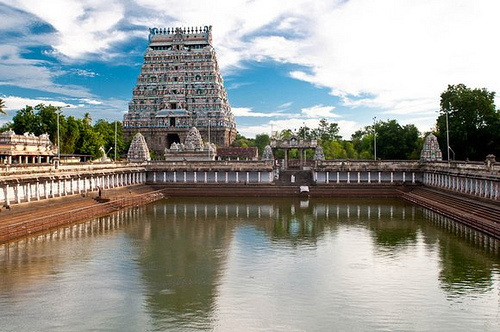
Address: Sri Thillai Natarajar Temple, Chidambaram-608 001, Cuddalore district
Opening Time of the Day: It opens from 6.00 a.m. to 12.30 p.m. and from 4.30 p.m. to 10.00 p.m.
Nearby Railway Station : Chidambaram
Nearby Airport : Trichy
One of the unique features of the temple is festooned image of the Nataraj!! And, it shows the Lord Shiva as a dancing Lord of the form Bharatnatayam. Nataraja is one of those few temples where Lord Shiva has been represented in the form of anthropomorphic idol rather than the anionic Lingam which is considered to be the classic form of the Lord Shiva idol. The celestial dance of Lord Shiva as Nataraja depicts the Universe motion that is sustained by Lord Shiva.
Chidambaram is also known with various other names such as Thillai which came into being after the name of the Thillai forest where the temple is located now, Perumpatrapuliyur or Vyagrapuram which came into being for honouring saint Vyagrapathar. It is considered that the temple as been located at the heart of the Universe known as Virat Hridya Padma Sthalam.
The place where Lord Shiva displayed his dancing bliss is now called as Ponnambalam/ Porsabai which means a gold stage and the place is just in South of the Thirumoolataaneswar temple. That is the reason Lord is also known with the name Sabhanayakar which means the God of the stage.
This gold-roofed stage has the representation of the Lord in three forms:
1. The FormThe appearance of Lord Nataraja called as Sakala thirumeni which is the anthromorphological form.
2. The Semi-formThis one is the semi anthropomorphologial form represented as Crystal Linga, the Sakala nishkala thirumeni.
3. The FormlessIt is the place in the Chidambara Rahasyam which is represented as an empty space, Nishkala thirumeni within the sanctum sanctorum.
HistoryThe leader of Rishis, sage Vashishta, had been associated with a relative called as Madyandinar. Sage Vashishat advised his son to worship Swayambulinga in Thillai Vanam forests, so as to gain spiritual wisdom completely. Upon which the boy went to the forest but since he could not do his Puja on the time as suggested by Vashishata, because he was busy in plucking flowers at that time and also because the flowers were not pure for the honey in these flowers had been taken away by the bees. And, so he appealed to Lord Shiva that he was late for the puja as he was not able to pick the flowers in darkness and also the flowers become unfit for puja if they are plucked after the Sunrise.
Upon his request, Lord Shiva blessed him with the legs and hands of tigers and a vision brighter enough so that he could see properly even in the darkness. And, Lord said that he would be henceforth called with the name Vyakrapada for he had legs and hands of that of a tiger. Vyakrapada was really ecstatic with the blessing and kept his puja continued in Thillai.
The region where the temple was built was once a dense forest with a great number of Thillai trees. Presently, you cannot see these trees on the very place. Nevertheless, their traces can be seen in the Pichavaram east of Chidambaram in the backyard area. While inside the temple, the stone tree is in the Tirumoolattanar shrine on the Western side. Before the Lord Nataraja shrine, the darshan of Lord Shiva, Bramha, and Vishnu is available from the mandap. The fact is worth noting that Lord Govindaraja Perumal temple of the Vaishnavite shrine is in the vicinity of the Nataraja shrine. Also, Thillai Kali temple who had challenged Lord Shiva in the completion of dance is present in the nearby area.
It is the general belief in the Hindu mythology that offering prayer to the Lord Nataraja, gives mental peace to the devotees. Offering prayer from a pure heart frees us from all types of health problems. Many people also pray Nataraja for gaining excellence in the field of art and also for finding the boon of prosperity and child.
The devotees offer puja by Abhisheka with milk, curd, cosmetic powders, green coconut, rose water, secret ashes and many more. They also show their gratitude by offering them with clean and fresh clothes. People also offer Kalbhishekam and Gangabhishekam to the Lord for getting happiness and prosperity in life. The devotees also pray the mother Sivakama Sundari by offering turmeric and sari. Those devotees who can afford also contribute for the overhaul of the temple.
Tunganath temple witnesses a great weather all through seasons.
Summers are apt for visiting the temple as that time it witnesses a moderate climate with an average temperature of 16 degree Celsius. This season is perfect for all the sightseeing and visiting the nearby attractions.
This season witnesses scanty rains! The period is particularly apt for sightseeing as at that time the panoramic view of the hills is very pleasurable.
These are chilly days with the minimum temperature touching at 4 degree Celsius! The minimum can also touch to sub zero level. Snow fall can also be seen during this season.
The most apt time to visit to the Tunganatha from April to November
The best season to visit Tunganath is from April to November.